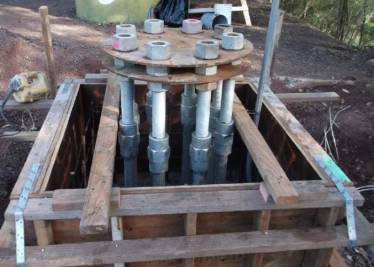How do you torque anchor bolts?
When tightening a nut onto anchor bolts, it is important to follow procedures to ensure proper installation and secure fastening. Here is a general outline:
- Clean the threads of any debris or rust using a wire brush or similar tool.
- If specified apply wax to threads and bearing surfaces.
- Place the nut on the anchor bolt and hand-tighten it until it’s flush with the anchor plate or structure.
This is done to prevent any cross-threading that may occur. - Tighten nuts to a snug tight condition.
Snug tight is defined by the AISC/RCSC as when all the plies in a connection have been pulled into firm contact by the bolts in the joint, and the bolts have been tightened sufficiently to prevent the removal of the nuts without a wrench. The AISC also states that in most scenarios, the normal effort of an ironworker with a regular spud wrench is sufficient to tighten the nuts to snug tight. If special pre-tensioning is required, the engineer should have carefully designed the anchor assembly specifically for that purpose and there should be detailed instructions so that the pretensioning is carried out properly. - Once snug tight is achieved tighten further to the designated value.
This is often done using a torque wrench, most of which have an adjustable handle or a digital display to set the desired torque value. Consult the manufacturer’s instructions or the specifications provided for your wrench to learn how to adjust the torque setting. Apply the torque gradually, using a sequence of tightening in each pass so that the nut on the opposite side will be subsequently tightened. This helps distribute the load evenly across each bolt. Avoid sudden or jerky movements that could affect the accuracy of the measurement. Please be aware, because of the many interrelated variables that directly or indirectly affect friction, such as surface texture, finish, lubrication, speed of tightening, human error, etc., it is possible to experience as much as ±25% deviation in preload (clamp load) with the use of a torque wrench. - In some special applications, there are procedures for tensioning anchor bolts using a modified turn-of-the-nut methodology where a torque wrench is not required.
The turn of the nut method is a guide that details the user to rotate the nut a specified amount depending on the bolt length and slope to achieve the required tension. The American Association of State Highway and Transportation Officials (AASHTO), in LRFD Specifications for Structural Supports for Highway Signs, Luminaires, and Traffic Signals, details turn of the nut methods for the top nut in double nut moment connections. Identical to assembly using a torque wrench, these rotation recommendations are for after the nut is snug tight. Turn of the nut method is as follows: Once snug tight condition is achieved, establish reference marks, and then tighten the top nuts by turning each nut 1/12 turn (1/2 of a nut flat) past snug-tight using either static or impact tightening. Turn each top nut an additional 1/12 turn until each nut has been tightened 1/6 total turn past snug-tight. - Make sure there is proper thread engagement to achieve the full strength of the anchor bolts.
Ideally, two full threads extend beyond the nut, however, this is often not the case. AISC Design Guide 1 writes that when the anchor rod is shorter than anticipated, it may be possible to partially engage the nut. An estimate of the resulting nut strength can be calculated based on the percentage of threads engaged on the condition that at least half of the threads in the nut are engaged. - Inspect the installation once the nut is tightened to ensure the assembly is securely fastened.
Verify the nut is flush against the bearing surface and not misaligned or damaged.

Please remember these are general guidelines. It is recommended to consult the engineer on record before final assembly for specific applications.
For your next anchor bolt project, please consider Portland Bolt! We carry a large selection of stock anchor bolts and nuts ranging from ½” to 2-1/2” diameter in many different ASTM specifications. These are provided with a plain and galvanized finish, with our F1554 grade 36 hex head anchor bolts ready for immediate shipment. We stock a wider range of these anchor bolts in a hot-dip galvanized finish than in a plain finish. Galvanized anchor bolts can usually be substituted for plain finish anchor bolts, especially when a quick delivery is required. If substituting a galvanized anchor bolt is unacceptable, Portland Bolt can manufacture F1554 grade 36 headed anchor bolts in a plain finish. All stock F1554 headed anchor bolts have a 4″ or 6” thread length. Please reach out to one of our experience salespeople, we look forward to assisting you with your next project!




